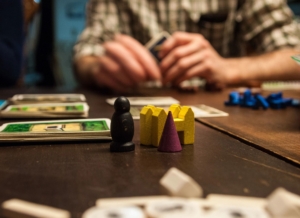Board Games for Enhancing UX Teams
By Chris Hass, President, Create Logic LLC
October, 2019

On this World Usability Day as we think about design for the future, let’s take a look at a rapidly evolving field that finds itself racing into the future: tabletop games. There’s a board game renaissance going on. Whether your board game tastes are social or strategic, if you’re inclined to play solo or with others, evolving board and card game designs are taking tabletop gaming out of the realm of simple diversions and inviting players into interactive experiences with surprising, impactful challenges that build empathy, broaden perspectives, and provide valuable insights into how individuals and teams solve problems, communicate, and succeed professionally.
Emerging and established tabletop games invite the questions: what can a board game teach you about your team? Which games are engaging and useful to play in professional UX circles? As with many questions, it’s difficult to be definitive. The industry-standard catalog of published tabletop games, Board Game Geek, includes more than 100,400 published games in its database. Nevertheless, based on primary gaming experiences in collegial and professional settings, it’s possible to identify the following sets of tabletop games that are fun, suited to a variety of gaming environments and gaming tastes, and that provide specific benefits for UX-related professional teams and organizations.
Selection
When selecting a game to play with colleagues, your team, or your clients, it’s helpful to think about the character of your potential players. Is your team highly social or quietly methodical? Would they welcome games with a lot of playful “take that!” opportunities to derail each other’s plans, or would they be likely to resonate with less interactive challenges that allow them to rise or fall as individuals based on their own strategies? Would they welcome a shared challenge, offered by the many cooperative games available, or play a more “every player for themselves” game?
The games we select should fit the play style of the players, their available time, how social they’d like to be, and be based upon an understanding of the specific style of gameplay each game offers. Some games are highly social and rules can be fluid, others are highly regimented offering nearly solitary experiences as players play. All of these factors help us to calibrate our game choices and to set expectations with players. There are no hard and fast rules about offering a social game to methodical players, or a methodical game to social players, but a general awareness of players’ preferences can help build momentum. Beyond game selection, it’s important to have at least one person involved who has played before, knows the rules, and ideally has some facility for introducing the game meaningfully to others.
With these things in mind, what can tabletop (board) games offer to UX professionals?
Insights
Board games offer us unique windows into how we think and solve problems. One game that is particularly good at illuminating the different ways players approach a challenge and is suited for business environments (easy to learn, fast to play) is the game Concept. To play Concept, players place colored cubes on a game board filled with symbolic icons in an attempt get others to guess specific words or phrases. Concept can be played with a group of virtually any size, with players dropping in and out of the game as their interests and time allow. It’s an intriguing, social game that can be set up in an office break room, a side table, or the hallway of the UXPA International conference between sessions. (I’ve done all three.) How players assign cubes and utilize the available symbols to get others to guess “Harry Potter” or the phrase “Make hay while the sun shines” without being able to speak can be both highly enjoyable and an engaging, low-risk challenge. Playing this Rorschach test of a game offers insights into how individuals break problems into sequences of additive clues until understanding is reached. After playing, we invariably better understand how our colleagues, and we ourselves, think. Concept could be a work-day diversion, a low-key team-building exercise, or perhaps even part of a hiring process to see how newcomers frame their choices and how they adjust their approaches to the guesses of their prospective colleagues.
Through gameplay, cooperative board games can offer us insights into how individuals approach challenges, how they handle stress, how teams communicate, and they can give us ideas for more effective professional approaches for team communication and problem solving based on what we experience and observe. In the bestselling game Pandemic players team up to thwart four runaway plagues simultaneously infecting the cities of the world. Though the game mechanics are relatively simple, players’ turn by turn efforts require situational assessment, planning, cooperation, coordination, and a little bit of luck to save the day. Observing how friends, colleagues, and family members approach this challenge can be insightful: do one or two players end up directing the others? Are players able to convince others to adopt strategy changes? How does the group manage disagreements? What might their evolving team dynamics tell you as a team manager?
Another bestselling cooperative game, The Captain is Dead, offers a similar “all hands on deck” challenge but the deck in this case is the command deck of a starship. Players assume the archetypical roles of up to seven members of a fictional starship command crew in dire circumstances. The ship’s captain has been killed, the ship is heavily damaged, aliens are attacking the ship in waves, and though players have defined roles (e.g., Doctor, Engineer) with unique abilities, they must as a group coordinate their responses to increasingly dire (and sometimes absurd) situational challenges in order for the ship to survive. Fun, funny, frenetic, and unflinchingly challenging, The Captain is Dead takes a premise familiar to science fiction fans, makes it accessible to non-fans, and offers an enjoyable, memorable, non-work-related way to see how your team handles stressful challenges.
Practice
There are games, of course, that are more squarely in our professional wheelhouse. The game UX in the Jungle challenges teams of players to guide their User Experience team as it mollifies mercurial stakeholders and delivers the most profitable mobile app to market. Whichever team achieves the highest profit margin wins. As teams move through the research, design, and development activities traditionally associated with a successful human-centered design process, they work together to maximize their decision-making to deliver their app on time, on budget, and to spec. For UX teams and their leadership, UX in the Jungle offers direct insights (and insider fun) into the value of UX in discovery, design, and development processes, and offers discussion opportunities to reflect on a team, or organization’s, real-world practices.
For client-facing teams, account managers, sales and business development personnel, tabletop games can offer fun ways to use and enhance their professional skills. In the German card game Bohnanza, players attempt to negotiate for, plant, and harvest the most profitable garden beans from available choices. (The name Bohnanza is a language pun, as the German word for “bean” is “bohn.”) The player with the most profitable garden at the end of the game, wins. Because every turn players trade cards to complete sets of beans, they are encouraged to dream up complex, sprawling negotiations the result of which may owe more to a silver-tongued player talking everyone else into a tragically one-sided trade than fairness. In fact, the most memorable game of Bohnanza I’ve played included two pharmaceutical sales reps. Their banter, professional sales skills, and trade-ingenuity left us all hypnotized – and with no chance of keeping up. Silly, creativity inspiring, and fast-paced, Bohnanza is a go-to game for showing off (or improving) negotiation skills.
Vye: The Card Game of Capture and Control offers a quieter, more artful set of challenges that is no less strategic. Vye has an easy to learn premise: players represent nobles vying for power in the (temporary) absence of the Inevitable Empress. Players have until she returns to acquire land (represented by cards with uniquely beautiful nature-based artwork). Games can be quick and though Vye is simple to learn, it offers strategic complexity. Upon the Inevitable Empress’s return, the player with the largest contiguous set of land cards wins. This game is so enjoyable and useful as a professional icebreaker that I created a miniature version to keep in my work bag so that it’s nearly always with me. I’ve played it with colleagues, potential clients, in pubs, conference hallways, living rooms, board rooms, and well, anywhere people will play it with me.
Empathy
One of the greatest powers a good tabletop gaming experience can provide is the ability to shift our perspectives. Players might assume the role of a deity (Spirit Island), a merchant (Lords of Waterdeep), a criminal (Grifters), a pie enthusiast (My Little Scythe), a pirate (Merchants and Marauders), a soldier (Memoir ‘44), a healer (Dice Hospital), an art collector (The Gallerist), a railroad planner (Ticket to Ride), a gardener (Herbalism), a scientist (Xenon Profiteer), or any of a seemingly endless series of roles that help us escape our reality-based boundaries.
Our emotional involvement in these roles can be fleeting or profoundly impactful. The tabletop game This War of Mine (TWoM), offers uniquely engrossing gameplay that is logistically challenging in its complexity and uniquely brilliant in its subtle ability to elicit powerful emotional attachment between players and the characters whose actions they direct. Adapted from a groundbreaking video game of the same name TWoM challenges players to safeguard a handful of characters through a series of days living in a post-war bombed out shell of a house surrounded by the lawless and morally conflicting post-war landscape of a city without rules. Designed by a native of Sarajevo, TWoM’s express purpose is to prevent future wars through a deeply immersive, emotive exploration of war’s aftermath.
One of the most unique aspects of TWoM is that characters’ mental state is as vital to their survival as meeting their basic needs (safety, shelter, food). Players might choose to have one of the characters spend vital, limited activity time assembling a radio from found parts because the “normalcy” of spending a few minutes a day listening to classical music gives that character the emotional strength to face the surviving in a city devoid of normalcy. Safeguarding characters’ health and well-being can take an emotional toll on players: The exuberant joy of discovering desperately needed canned foodstuffs at the end of a dangerous trek across town can come to a heart-wrenching turn upon returning home when your characters discover that in their absence thieves have stolen the meagre resources they had stockpiled and injured the character you left on watch. On the face of it, This War of Mine might not sound like much fun. And, for the most part, it isn’t- in the traditional sense. Where many games entice players to become super-human through weapons, tiered challenges, and countless power-ups that place players at the heart of their own hero journey, This War of Mine, through its seemingly mundane challenges (finding food, patching a bomb-damaged wall before cold weather comes) and the emotional investment it engenders in players to safeguard the mental health of its characters, reminds us in deeply engrossing, empathy-inspiring ways that our outlooks and our community ARE our superpowers. Paradoxically, while the game’s theme and challenges are dark, they are surprisingly, brilliantly, effective at achieving two seemingly disparate goals: providing unique and memorable gaming experiences, and demonstrating in powerfully effective ways that violence, war, and separatism have dire consequences for those who survive them. Complex to learn and lengthy to play, TWoM might not be for everyone, but for UX teams up to the challenge who are seeking a “renewal of purpose” regarding the importance of empathy in UX, playing This War of Mine could provide a power-up.
Inspiration
Where a game like This War of Mine throws the indomitability of the human spirit into the spotlight, other games remind us in less extreme ways that our world is full of beauty and the potential for human endeavors to expand our horizons is beyond imagination. For example, the game Wingspan offers players a gentler, more eco-friendly challenge. In Wingspan, players endeavor to entice birds into one of three ecosystems they manage: forest, grassland, or wetland. Successfully integrated birds in turn provides players with resources (food, eggs, cards) that they can use to foster their evolving plans. Wildly popular, Wingspan was written up recently in The New York Times where it was lauded for its breathtaking artwork, innovative and accessible gameplay, and its scientific accuracy. (Birds in the game are depicted realistically and feature “stats” that are indicative of their real-world habits.) It’s a game that equally comfortable on a conference table, dinner table, or in a middle-school science class. Players play largely individually, vying only for cards that appeal to them, using the birds they collect to provide needed resources that enable them to achieve game-related goals. Wingspan is an engaging game of medium complexity that quietly enhances our empathy for Nature and underscores the rewarding challenges of designing processes that are elegant and effective.
Other games provide inspiration on a broader horizon. Terraforming Mars invites individual players to work together to terraform our celestial neighbor but to come out ahead individually in the end as the most revered corporation involved in the terraforming process. Players use cards, tile placement, and ever shifting strategies to make Mars’ atmosphere breathable, its temperature suitable for life, and to bring its oceans back. In a manner similar to other games mentioned, how players interact, the strategies they attempt and refine, how they communicate, and which aspects of the game they resonate with provide insights into individual and team behavior. The game’s theme and the gameplay it offers remind us of the importance of science in our lives and that the horizons we may someday traverse are beyond the ones we see today.
Games themselves, with their evolving variety of gameplay mechanisms, themes, challenges, and innovative approaches may offer inspiration as we examine (or opine about) their visual design, interaction design, usability, the quality of their instruction manual content, and other aspects of the games. Games can provide great object lessons of good and bad UX that are instructive, discussion worthy, and thought-provoking. UXers are not shy about pointing out the highs and lows of interaction designs they encounter, and tabletop games should be no different.
Escape
Setting aside games’ loftier ambitions, some games are designed for simply having fun and letting loose. King of Tokyo puts players in charge of giant, city-crushing monsters duking it out for the honor of being the last monster standing. Fun, easy to learn, and fast-paced, players chuck dice, press their luck, and use unique powers to best their opponents. Flick ‘em Up: Dead of Winter provides physical challenges. To play this dexterity game, players set up a small town on a largeish table and literally flick game pieces across the table, hoping to knock down zombie tokens with a well-placed flick. It’s silly, it inevitably involves chasing a game piece across the room, and it’s thoroughly enjoyable. These games are good reminders that it’s good practice to just cut loose sometimes (but try to keep your pieces on the table!).
I’d be remiss if I didn’t mention role playing games as well. Dungeons & Dragons, Fate Accelerated, Gloomhaven, Fiasco (a storytelling game), Monster of the Week, and countless other role playing “systems” offer frameworks of varying complexity to support teams’ ability to invent a character, band together, and tackle adventures on virtually any plane of existence or theme. There can be tremendous value in shared sequential gameplay over time, inside or outside of work hours where colleagues can come together, dream, and face fun challenges.
Connection
Sitting across the table from other players, focusing on a game or chatting about other matters as a game progresses brings social benefit. Interacting with colleagues on neutral ground, sharing a laugh or commenting on a particularly clever play, helps us to see each other in new contexts and helps to free our thoughts from their familiar pathways. For distributed teams, there are a plethora of digital services that support long-distance tabletop gaming. Some of the most popular include Tabletop Simulator, Tabletopia, and Roll20 (for Dungeons & Dragons-like role playing games). Game publishers may offer their own multi-user mobile apps to pair up players for a specific game. Others license their games to services like Tabletopia to provide a shared, online, browser-based space pre-loaded with hundreds of board games where players can view and manipulate game pieces around a virtual table, as if they were across the room from each other. To bring geographically distributed UX teams together, one or more of these services might be ideal.
The Future
As digital and real-world environments collide, how they will come together to support tabletop gaming remains to be seen. Many companies have tried to create digital display tables that recognize game pieces with embedded RFID tags, and to date none has achieved mainstream acceptance or adoption. It is becoming more common for tabletop game publishers to offer apps that accompany their games to make scenarios easier to understand and to help with scoring. Some gaming “purists” reject these nascent efforts to bring digital efficiency to analog experiences but the trend persists. And the quest continues for a truer fusion of online and offline experiences: Recently the company Tilt Five launched its second attempt in this space via a Kickstarter campaign offering “Augmented Reality glasses that open up a whole new holographic game space” for tabletop gamers. Their equipment is lighter, more capable, and offers more games out of the box, as well as a developer’s kit. Will it succeed? Time will tell.
What we can say about the future of tabletop gaming is that more people than ever are engaging with board games, which means they’re spending more time with each other in the real or communication-supported worlds, and that offers us ample opportunity for similar engagement and for understanding the appeal, impact, and utility of games.
Summary
Whatever your game play preferences, whether your team needs some easy games to ramp up into a routine gaming experience, or whether you’re seeking to understand how your colleagues think, respond to challenges, and how you might think differently about team makeup and the team dynamics you find yourselves frequenting, there are games for every taste and environment.
Inevitably, this list is incomplete. It very likely omits one or more of your favorites, or the suggestions aren’t quite germane for your professional scenario. Let’s see that as an opportunity for continued dialog, shared tabletop gaming experiences, and more games!
What are your favorite games to play in professional settings, and why?
By Chris Hass, President, Create Logic LLC
Email: chris@createwww.com | Twitter: @chrishass | LinkedIn: linkedin.com/in/chrishass/












